All Data Structures & Algorithms
1/403
There's no tags or description
Looks like no tags are added yet.
Name | Mastery | Learn | Test | Matching | Spaced |
|---|
No study sessions yet.
404 Terms
Selection Sort Definition
a sorting algorithm that treats the input as two parts, sorted and unsorted, and repeatedly selects the proper next value to move from the unsorted part to the end of the sorted part.
Selection Sort Algorithm
for i in range(len(numbers) - 1):
# Find index of smallest remaining element
index_smallest = i
for j in range(i + 1, len(numbers)):
if numbers[j] < numbers[index_smallest]:
index_smallest = j
# Swap numbers[i] and numbers[index_smallest]
temp = numbers[i]
numbers[i] = numbers[index_smallest]
numbers[index_smallest] = temp
Insertion Sort Definition
a sorting algorithm that treats the input as two parts, sorted and unsorted, and repeatedly inserts the next value from the unsorted part into the correct location in the sorted part.
Insertion Sort Algorithm
for i in range(1, len(numbers)):
j = i
# Insert numbers[i] into sorted part
# stopping once numbers[i] in correct position
while j > 0 and numbers[j] < numbers[j - 1]:
# Swap numbers[j] and numbers[j - 1]
temp = numbers[j]
numbers[j] = numbers[j - 1]
numbers[j - 1] = temp
j = j - 1
Quick Sort Definition
a sorting algorithm that repeatedly partitions the input into low and high parts (each unsorted), and then recursively sorts each of those parts.
Quick Sort Algorithm
def partition(numbers, i, k):
# Pick middle value as pivot
Midpoint = i + (k - i) // 2
Pivot = numbers[midpoint]
# Initialize variables
done = False
l = i
h = k
while not done:
# Increment l while numbers[l] < pivot
while numbers[l] < pivot:
l = l + 1
# Decrement h while pivot < numbers[h]
while pivot < numbers[h]:
h = h - 1
# If there are zero or one items remaining,
# all numbers are partitioned. Return h
if l >= h:
done = True
else:
# Swap numbers[l] and numbers[h],
# update l and h
temp = numbers[l]
numbers[l] = numbers[h]
numbers[h] = temp
l = l + 1
h = h - 1
return h
Merge Sort Definition
a sorting algorithm that divides a list into two halves, recursively sorts each half, and then merges the sorted halves to produce a sorted list.
Merge Sort Algorithm
def algorithm(numbers, i, j, k):
# Create temporary list merged_numbers
# Initialize position variables
# Add smallest element to merged numbers
while left_pos <= j and right_pos <= k:
if numbers[left_pos] <= numbers[right_pos]:
merged_numbers[merge_pos] = numbers[left_pos]
left_pos = left_pos + 1
else:
merged_numbers[merge_pos] = numbers[right_pos]
right_pos = right_pos + 1
merge_pos = merge_pos + 1
# If left partition not empty, add remaining elements
while left_pos <= j:
merged_numbers[merge_pos] = numbers[left_pos]
left_pos = left_pos + 1
merge_pos = merge_pos + 1
# If right partition not empty, add remaining elements
while right_pos <= k:
merged_numbers[merge_pos] = numbers[right_pos]
right_pos = right_pos + 1
merge_pos = merge_pos + 1
# Copy merge number back to numbers
for merge_pos in range(merged_size):
numbers[i + merge_pos] = merged_numbers[merge_pos]
Radix Sort Definition
a sorting algorithm designed specifically for integers. The algorithm makes use of a concept called buckets and is a type of bucket sort.
Radix Sort Algorithm
Algorithm(array, arraySize) {
buckets = create array of 10 buckets
// Find the max length, in number of digits
maxDigits = RadixGetMaxLength(array, arraySize)
// Start with the least significant digit
pow10 = 1
for (digitIndex = 0; digitIndex < maxDigits; digitIndex++) {
for (i = 0; i < arraySize; i++) {
bucketIndex = abs(array[i] / pow10) % 10
Append array[i] to buckets[bucketIndex]
}
arrayIndex = 0
for (i = 0; i < 10; i++) {
for (j = 0; j < buckets[i]⇢size(); j++)
array[arrayIndex++] = buckets[i][j]
}
pow10 = 10 * pow10
Clear all buckets
}
}
Shell Sort Definition
a sorting algorithm that treats the input as a collection of interleaved lists, and sorts each list individually with a variant of the insertion sort algorithm. Uses gap values to determine the number of interleaved lists.
Shell Sort Algorithm
def algorithm(numbers, start_index, gap):
for i in range(start_index + gap, len(numbers), gap):
j = i
while (j - gap >= start_index) and (numbers[j] < numbers[j - gap]):
temp = numbers[j]
numbers[j] = numbers[j - gap]
numbers[j - gap] = temp
j = j - gap
Bubble Sort Definition
a sorting algorithm that iterates through a list, comparing and swapping adjacent elements if the second element is less than the first element. Uses nested loops.
Bubble Sort Algorithm
Algorithm(numbers, numbersSize) {
for (i = 0; i < numbersSize - 1; i++) {
for (j = 0; j < numbersSize - i - 1; j++) {
if (numbers[j] > numbers[j+1]) {
temp = numbers[j]
numbers[j] = numbers[j + 1]
numbers[j + 1] = temp
}
}
}
}
Quickselect
an algorithm that selects the k^th smallest element in a list. Ex: Running on the list (15, 73, 5, 88, 9) with k = 0, returns the smallest element in the list, or 5.
Quickselect algorithm
def algorithm(numbers, start_index, end_index, k):
if start_index >= end_index:
return numbers[start_index]
low_last_index = partition(numbers, start_index, end_index)
if k <= low_last_index:
return quickselect(numbers, start_index, low_last_index, k)
return quickselect(numbers, low_last_index + 1, end_index, k)
Heap Sort
a sorting algorithm that takes advantage of a max-heap's properties by repeatedly removing the max and building a sorted array in reverse order.
Heap Sort Algorithm
Algorithm(numbers, numbersSize) {
//Heapify numbers
for (i = numbersSize / 2 - 1; i >= 0; i--) {
MaxHeapPercolateDown(i, numbers, numbersSize)
}
for (i = numbersSize - 1; i > 0; i--) {
Swap numbers[0] and numbers[i]
MaxHeapPercolateDown(0, numbers, i)
}
}
Bucket Sort
a numerical sorting algorithm that distributes numbers into buckets, sorts each bucket with an additional sorting algorithm, and then concatenates buckets together to build the sorted result.
Bucket Sort Algorithm
Algorithm(numbers, numbersSize, bucketCount) {
if (numbersSize < 1)
return
buckets = Create list of bucketCount buckets
// Find the maximum value
maxValue = numbers[0]
for (i = 1; i < numbersSize; i++) {
if (numbers[i] > maxValue)
maxValue = numbers[i]
}
// Put each number in a bucket
for each (number in numbers) {
index = floor(number * bucketCount / (maxValue + 1))
Append number to buckets[index]
}
// Sort each bucket
for each (bucket in buckets)
Sort(bucket)
// Combine all buckets back into numbers list
result = Concatenate all buckets together
Copy result to numbers
}
Pre-Order Traversal
In this traversal method, the root node is visited first, then the left subtree and finally the right subtree.
If a binary tree is traversed in this method, it can be used to duplicate the tree.
Post-order Traversal
In this traversal method, the root node is visited last, hence the name. First we traverse the left subtree, then the right subtree and finally the root node.
If a binary tree is traversed in this method, the tree can be deleted.
In-order Traversal
In this traversal method, the left subtree is visited first, then the root and later the right sub-tree. We should always remember that every node may represent a subtree itself.
If a binary tree is traversed in this method, the output will produce sorted key values in an ascending order.
Bubble Sort, Selection Sort, Insertion Sort Time Complexity
Average = Θ(n^2 )
Big-O worst = O(n^2 )
Fast = No
Quick Sort Time Complexity
Average = Θ(n log(n))
Big-O worst = O(n^2 )
Fast = Yes
Bucket Sort Time Complexity
Average = Θ(n)
Big-O worst = O(n^2 )
Fast = Yes
Heap Sort, Merge Sort Time Complexity
Average = Θ(n log(n))
Big-O worst = O(n log(n))
Fast = Yes
Radix Sort Time Complexity
Average = Θ(n)
Big-O worst = O(n)
Fast = Yes
A functions whose cost scales linearly with the size of the input
O(n)
Iterating over a collection of data once often indicates an ______ algorithm. (alphabet for-loop example)
O(n)
A functions whose cost scales logarithmically with the input size
O(log n)
Which type of function works by breaking down large problem into smaller and smaller chunks?
recursive
As the size of the input grows the cost of the algorithm does not increase at the same rate. The overall cost of performing an operation on 1,000,000 items is only twice that of performing the operation on 1,000 items.
O(log n)

A function that exhibits quadratic growth relative to the input size
O(n^2)
An example of this type of function is doubly nested loop
O(n^2)
Which type of function gets really expensive really quickly?
O(n^2)

A function that has two inputs that contribute to growth
O(nm)
An example of this type of function is when there is a nested loop that iterates of two distinct collections of data
O(nm)
Are Big-O cases used in the best or worst situations?
Worst
Which statement is static?
readonly Contact[] contacts = new Contact[];
readonly Contact contacts = new Contacts[100];
readonly Contact contacts = new Contacts[100];
A container where data is stored in nodes consisting of a single data item and a reference to the next node
Linked List
A ______ is a container where nodes of data are linked together into a list
Linked List
Linking together complex nodes into a single structure
Linked List
Each link in a chain for a linked lists is called a ______
node
What two things do nodes contain?
1. the value
2. reference to next item in the list
Give a coded example on how to create a 3 chained linked list of nodes.
Node head = new Node(1);
head.Next = new Node(2);
head.Next.Next = new Node(3);
A list where we start at the first node and follow the chain of nodes iterating over each until we get to the end
Singly Linked List
A list that builds on the singly linked list by adding reverse iteration.
Doubly Linked List
Give a coded example on how to create a doubly linked list
Node node1 = new Node(1);
Node node2 = new Node(2);
Node node3 = new Node(3);
node1.Next = node2;
node2.Previous = node1;
node2.Next = node3;
node3.Previous = node2;
The first and last nodes of a doubly linked list should have a value of ______
null
Adds a value to the beginning of the list
AddHead
Adds a value at the end of the linked list
AddTail
Finds the first node whose value equals the provided argument
Find
Returns true if the specified value exists in the list, false otherwise
Contains
Removes the first node on the list whose value is equal to the argument
Remove
A doubly linked list where the values are inserted and sorted in order
Sorted List
Adds the specified item to the linked list in the sort order of the item type
Add
A way of organizing, storing, and performing operations on data
Data Structure
A data structure that stores subitems, with a name associated with each subitem.
record
A data structure that stores an ordered list of items, with each item is directly accessible by a positional index.
Array
A data structure that stores ordered list of items in nodes, where each node stores data and has a pointer to the next node.
linked list
A data structure in which each node stores data and has up to two children, known as a left child and a right child.
binary tree
A data structure that stores unordered items by mapping (or hashing) each item to a location in an array.
hash table
A tree that maintains the simple property that a node's key is greater than or equal to the node's childrens' keys.
max heap
A tree that maintains the simple property that a node's key is less than or equal to the node's childrens' keys.
min heap
A data structure for representing connections among items, and consists of vertices connected by edges.
graph
This represents an item in a graph.
vertex
This represents a connection between two vertices in a graph.
edge
A Last-in, First-out (LIFO) data container
Stack
When something is retrieved from a stack, does it come from the top or bottom of the stack?
Top
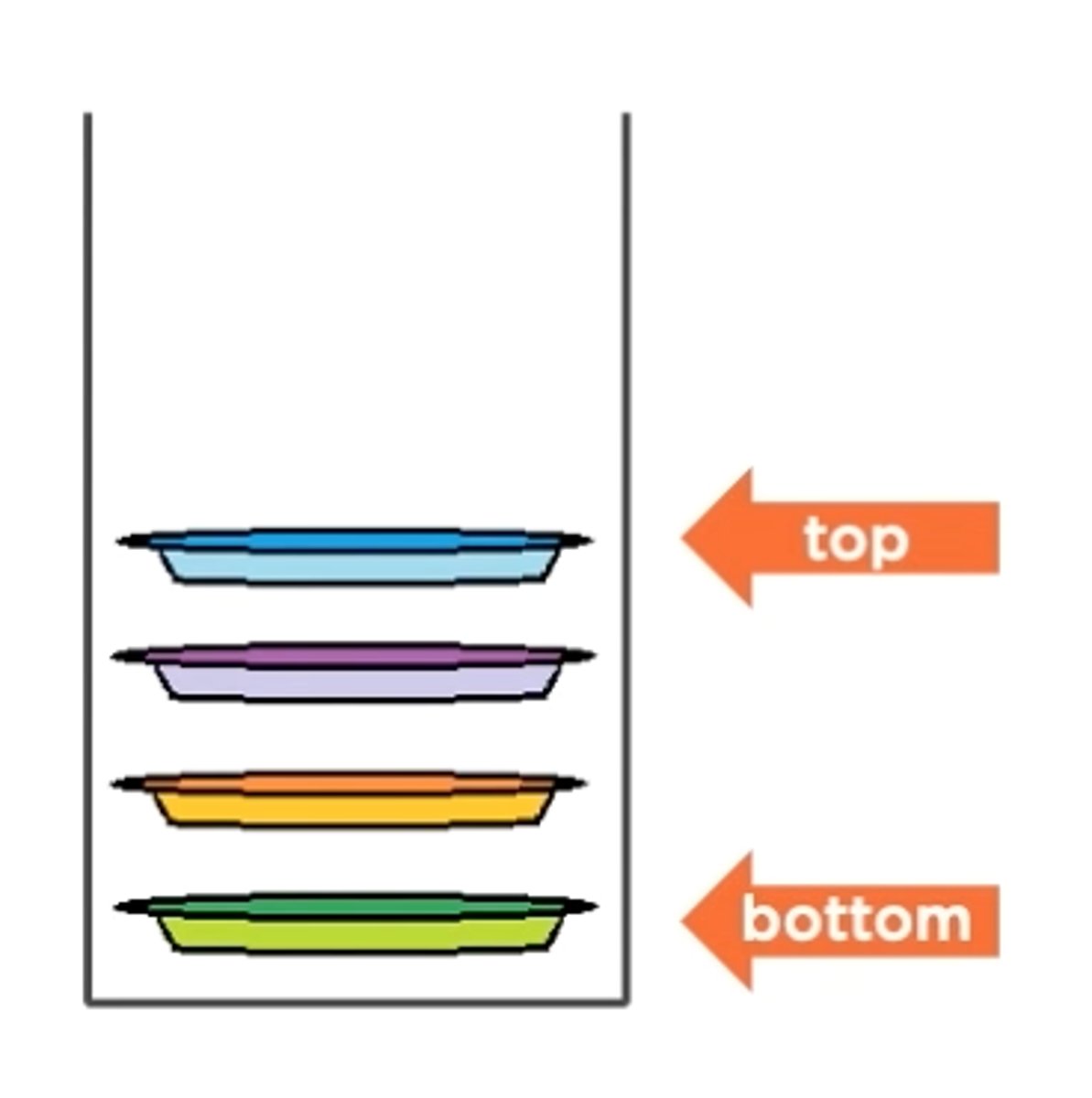
A First-in, First-out (FIFO) container
Queue
When something is removed from a queue, does it come from the head or the tail?
Head

When something is added to a queue, does it get added to the head or the tail?
Tail
A queue-like container which is both First-in, First-out and Last-in, Last-out
Doubly Ended Queue (deque)
Which type of function allows for items to be added or removed from the beginning or end?
Doubly Ended Queue (deque)
A data structure where nodes have parent-child (1:N) relationship
Tree
Each node in a Tree has at least ______ parent, but the number of children depends on the type of tree
one
Every node in a tree has how many parents?
one
Every part of a tree spawns how many children?
0 or more
Nodes that have no children are called what?
Leaf nodes
How many data items does each node on a tree contain?
one
At most how many children can each node have in a binary tree?
two
The maximum number of children that each node can have
Degree
The maximum amount of edges between that node and a leaf
Height
When smaller values are added to this tree smaller values are added to the left
Binary Search Tree
The smallest value in a binary search tree will be on the bottom most ______, while the largest value will be on the bottom most ______
left
right
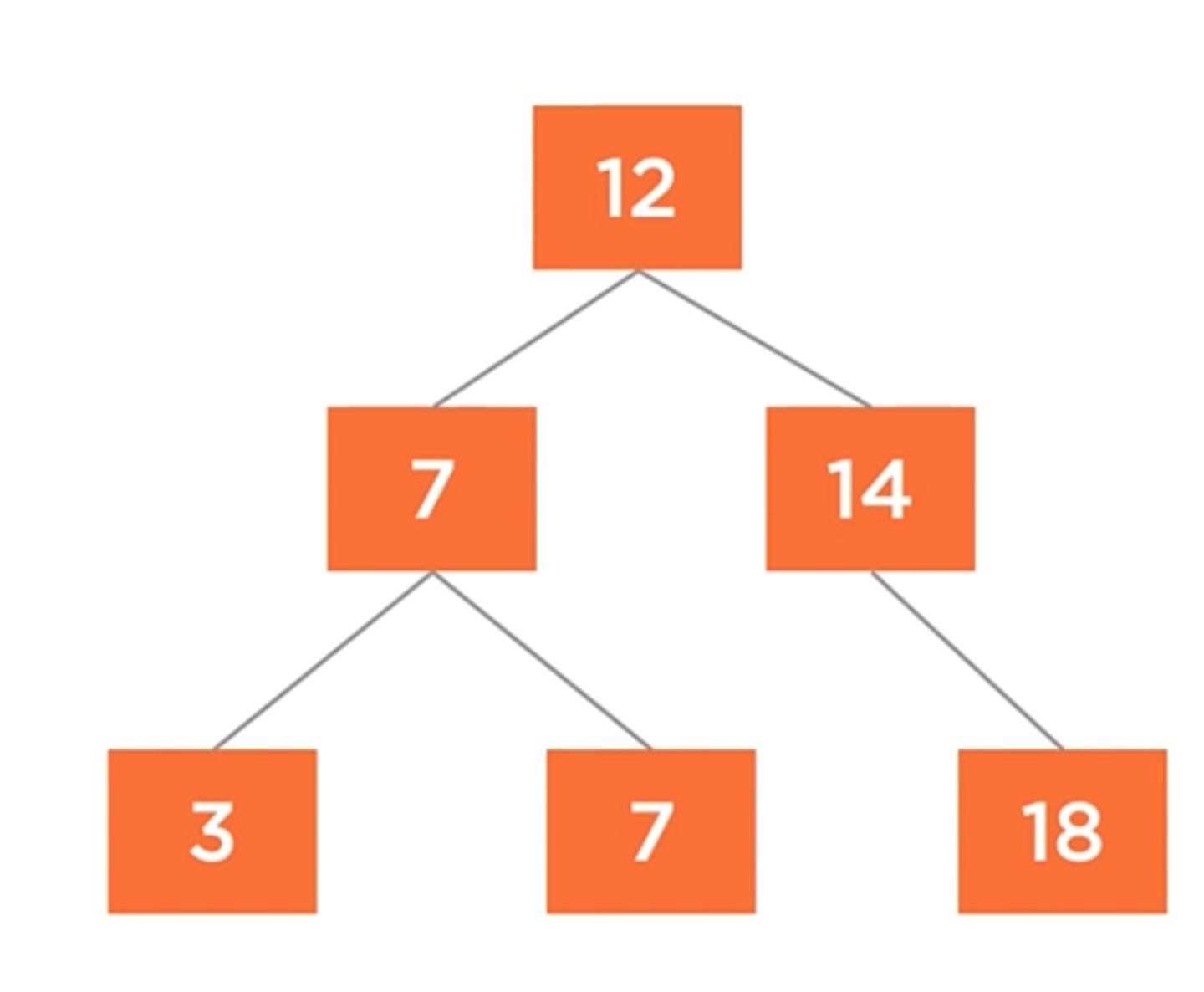
The insertion complexity on average of a binary search tree
O(long n)
The insertion complexity with the worst case of a binary search tree
O(n)
The node is visited before it's children
Pre-order
The left child is visited before the node, then the right child
In-order
The left and right children are visited before the node
Post-order
An example of why pre-order traversals are useful
To create an identical copy of a tree
What are in-order traversals useful for?
Sorting trees from least to greatest
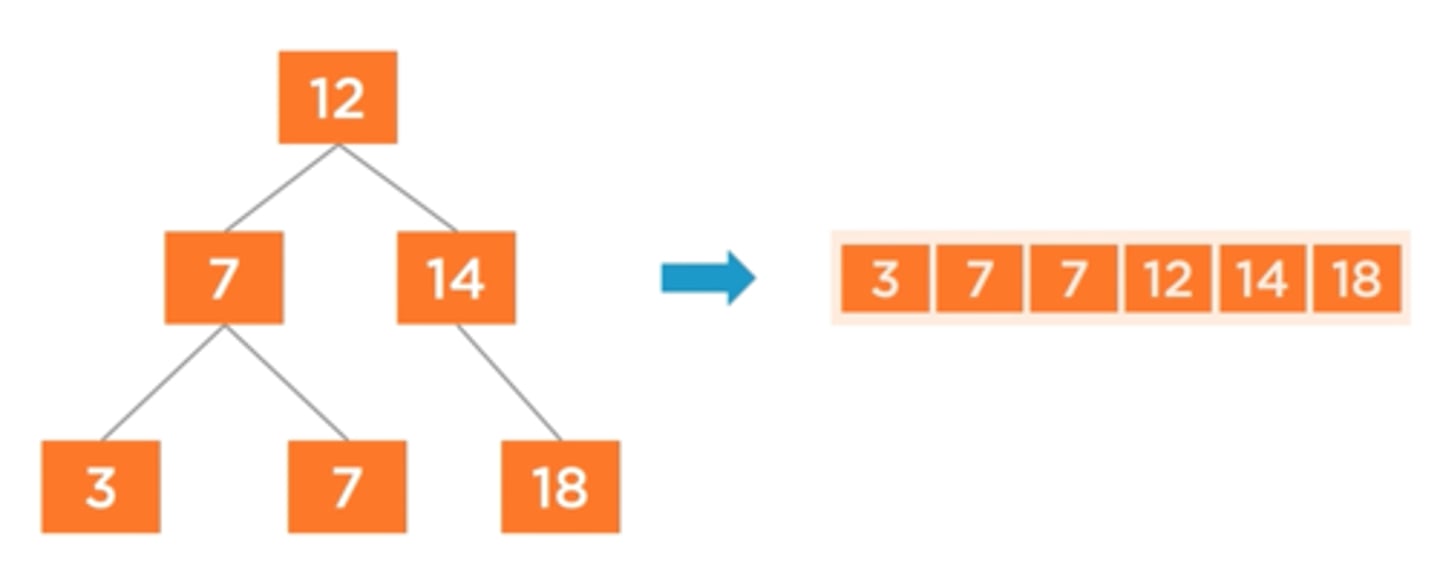
What are post-order traversals useful for?
To delete every node in a tree
The average case, best case and worst case for Traversal Complexity
O(n)
Searching in Binary Search Tree
O(log n)
How can a leaf node be removed from a tree?
Unlinking the node
How can a node with One Child be removed from a tree?
Promote the child
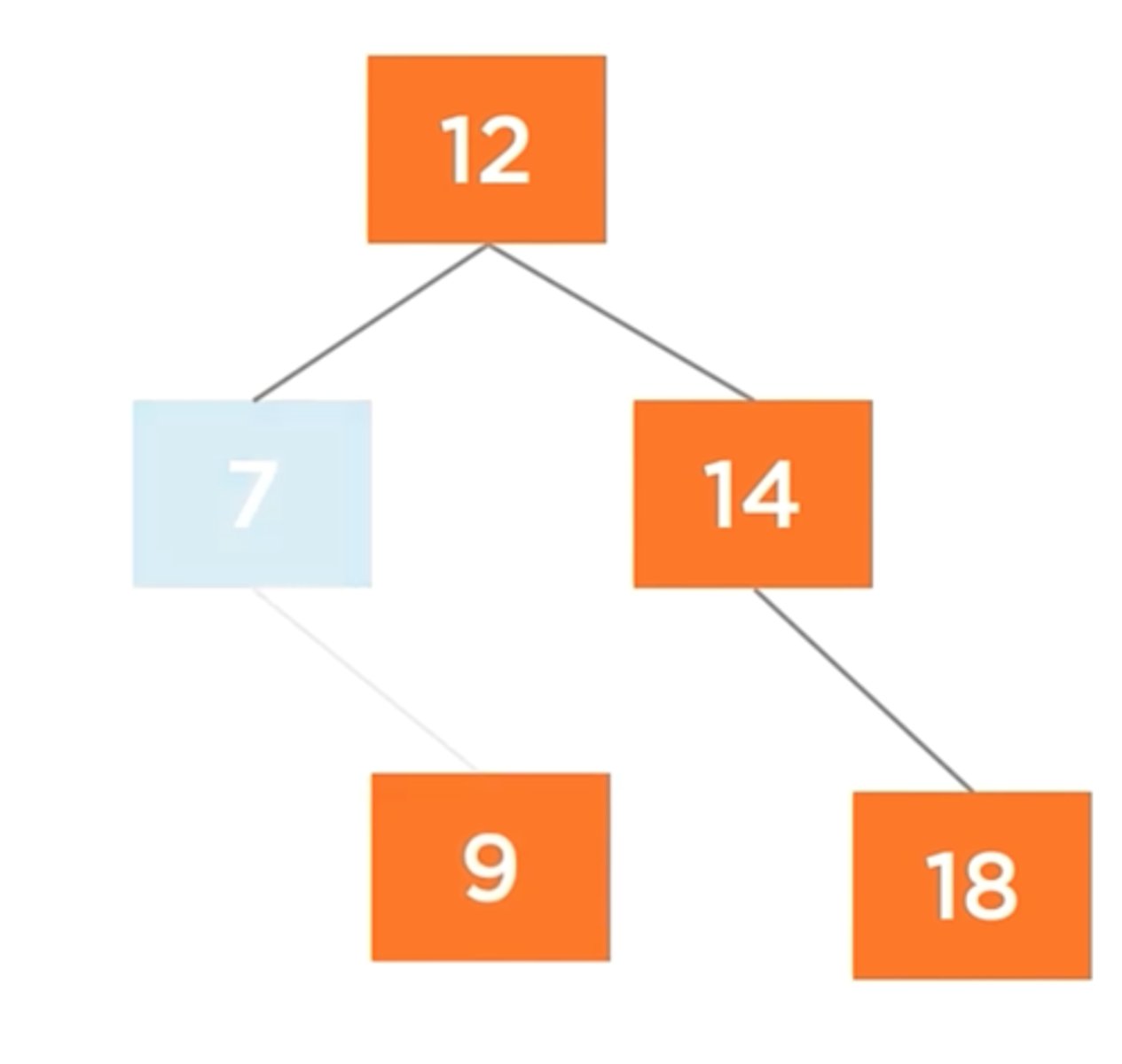
How can a node with Two Children be removed from a tree?
Move the successor's child up to the root node.
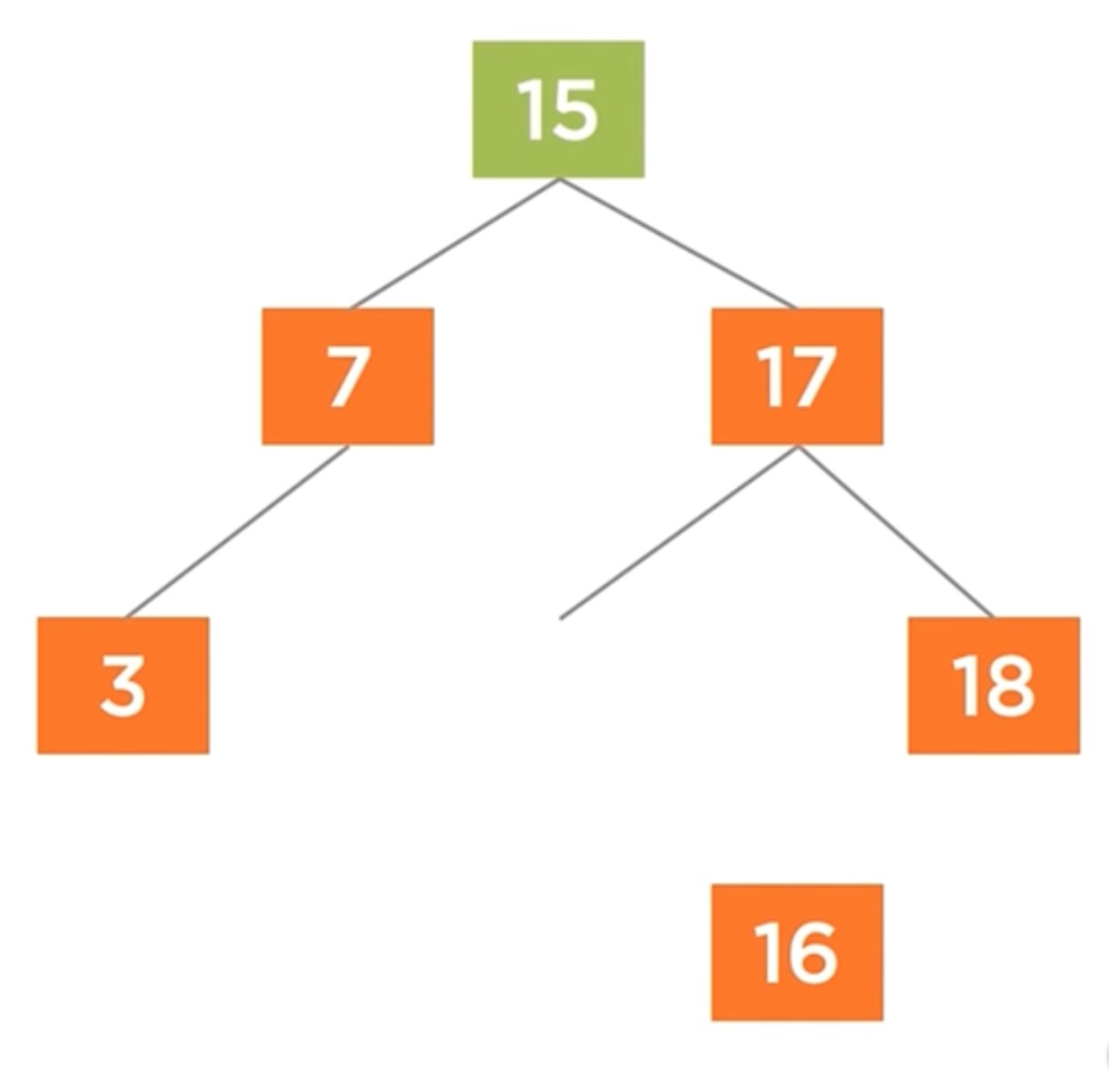
Removal Complexity in a Binary Tree
O(log n)